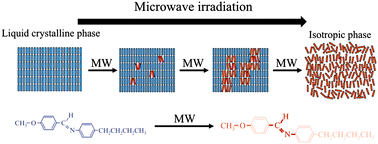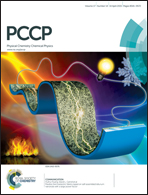The microwave heating mechanism of N-(4-methoxybenzyliden)-4-butylaniline in liquid crystalline and isotropic phases as determined using in situ microwave irradiation NMR spectroscopy†
Abstract
Microwave heating effects are widely used in the acceleration of organic, polymerization and enzymatic reactions. These effects are primarily caused by the local heating induced by microwave irradiation. However, the detailed molecular mechanisms associated with microwave heating effects on the chemical reactions are not yet well understood. This study investigated the microwave heating effect of N-(4-methoxybenzylidene)-4-butylaniline (MBBA) in liquid crystalline and isotropic phases using in situ microwave irradiation nuclear magnetic resonance (NMR) spectroscopy, by obtaining 1H NMR spectra of MBBA under microwave irradiation. When heated simply using the temperature control unit of the NMR instrument, the liquid crystalline MBBA was converted to the isotropic phase exactly at its phase transition temperature (Tc) of 41 °C. The application of microwave irradiation at 130 W for 90 s while maintaining the instrument temperature at 20 °C generated a small amount of isotropic phase within the bulk liquid crystal. The sample temperature of the liquid crystalline state obtained during microwave irradiation was estimated to be 35 °C by assessing the linewidths of the 1H NMR spectrum. This partial transition to the isotropic phase can be attributed to a non-equilibrium local heating state induced by the microwave irradiation. The application of microwave at 195 W for 5 min to isotropic MBBA while maintaining an instrument temperature of 50 °C raised the sample temperature to 160 °C. In this study, the MBBA temperature during microwave irradiation was estimated by measuring the temperature dependent chemical shifts of individual protons in the sample, and the different protons were found to indicate significantly different temperatures in the molecule. These results suggest that microwave heating polarizes bonds in polar functional groups, and this effect may partly explain the attendant acceleration of organic reactions.


 Please wait while we load your content...
Please wait while we load your content...